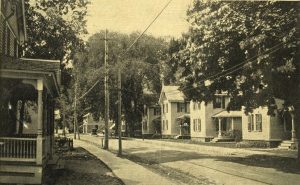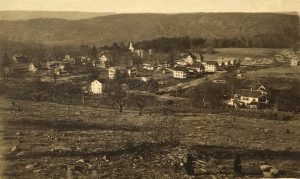By Elio Gugliotti, Editor
A place to call home

BEACON FALLS — If John Wolfe, superintendent of the Home Woolen Company, and other local businessmen who petitioned the state legislature in 1870 to create a new town had their way, Beacon Falls would be known by a cozier name: Home.
Wolfe — as in Wolfe Avenue — and some petitioners wanted to name the town after the company, which at the time operated out of a mill that is now the Beacon Mill Village Apartments along North Main Street.
In the end, the town was officially incorporated on June 30, 1871, and named Beacon Falls.
Before the town was incorporated, the area was known as Beacon Falls Village or the Beacon Falls Postal District of Bethany, according to Town Historian Michael Krenesky, who is also a selectman and president of the town’s historical society. The name came from the Beacon Hill area and Beacon Hill Brook, which runs behind the mill and has several natural falls.
The roughly 10 square miles of land that make up Beacon Falls came from Bethany, Oxford, Seymour and Naugatuck.
“I don’t think it was a difficult process, but you had to get all four towns to agree to give up their property,” Krenesky said.
Like many Valley towns, industry shaped Beacon Falls in its formative years.
The former factory downtown has gone by several names over the years. In 1898, the father-son duo of George Lewis and Tracy Lewis founded the Beacon Falls Rubber Shoe Company there. The company was known for its renowned brand of “Top Notch” rubber boots and shoes.
Krenesky said the two businessmen envisioned molding Beacon Falls into a company mill town, where workers lived and played. In 1915, he said, the men hired the Olmsted Brothers, which was established by the sons of famous landscape architect Frederick Law Olmsted, to design what is now referred to as the “Hill” neighborhood of town for workers.
A trolley that ran along the Naugatuck River carried workers from neighboring towns. Beacon Falls Rubber Shoe Company started the town’s first fire department, and built a movie house and a community center with a bowling alley along Main Street, Krenesky said.
During the company’s time in Beacon Falls, the town experienced a surge in population. The town’s population grew from 623 in 1900 to 1,600 in 1922, including an influx of European immigrants, according to connecticuthistory.org.
Krenesky said the company advertised in Europe to attract workers to Beacon Falls.
The United States Rubber Company, later known as Uniroyal, took over the plant in 1921, according to connecticuthistory.org. Nine years later, the company moved manufacturing to a plant in Naugatuck.
Over the years, Krenesky said the real changes in town are buildings, like Town Hall, moving from downtown up to the Hill neighborhood. He said the changes don’t necessarily have industrial origins.

“I think one of the largest things that we don’t talk about is Route 8,” he said.
The state built Route 8 through the center of town, what is now Main Street, in the 1930s and 1940s. What was once a one-lane dirt road became a highway.
Krenesky said some buildings downtown were moved or destroyed to make way for Route 8.
“That changed the entire complexion of what Main Street Beacon Falls is,” said Krenesky, noting the highway kept Main Street from developing into a typical New England downtown.
In the 1980s, the state upgraded Route 8, including building the section that now bypasses downtown all together.
Businesses like H.W. Wilcox Patent Medicines, a drug store that Krenesky’s parents, Michael and Beverly, owned downtown where Beacon Beer & Beverage is now, survived on the transient trade of truckers and people driving through town.
Krenesky said traffic dropped when Route 8 was moved and some businesses never made it back.
“We lost the trolley tracks and gained the highway,” he said. “I’m not sure that’s a good tradeoff.”
A natural disaster played its part, as well.
During the Flood of ’55, parts of Main Street were under 4 to 5 feet of water. Krenesky recalled water up to the counter in his parents’ store. The town lost land and buildings to the raging waters.
Beacon Falls remains one of the smallest towns in the state and is the fifth youngest. What hasn’t changed, is the town’s rural character as a suburban, bedroom community.
As the town prepares to celebrate its 150th anniversary, Krenesky said it’s important the town doesn’t lose its history.
“You need to understand where you came from to understand why you’re doing what you’re doing today, to understand what you need to change to go the future,” he said.













